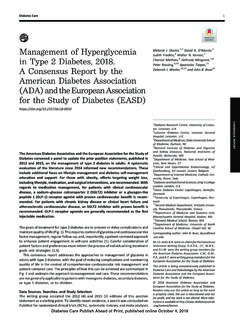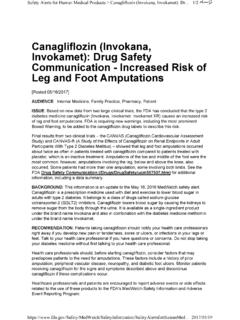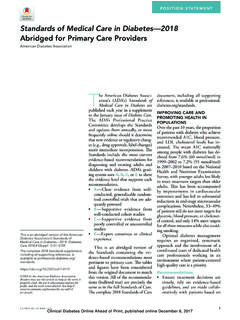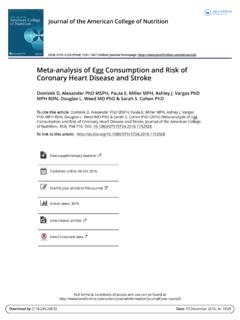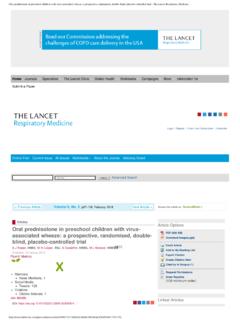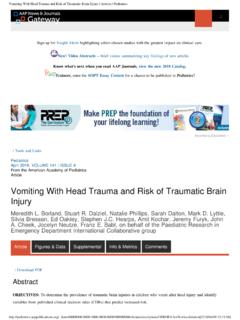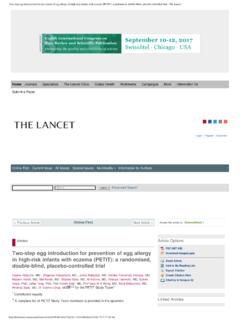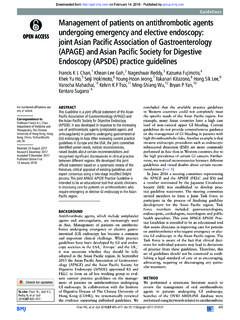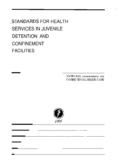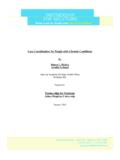Transcription of GOLD Executive Summary - さくらインターネットの ...
1 AJRCCM Articles in Press. Published on 27-January-2017 as Page 1 of 74. Global Strategy for the Diagnosis, Management, and Prevention of Chronic Obstructive Lung Disease 2017 Report gold Executive Summary Claus F. Vogelmeier1*, Gerard J. Criner2*, Fernando J. Martinez3*, Antonio Anzueto4, Peter J. Barnes5, Jean Bourbeau6, Bartolome R. Celli7, Rongchang Chen8, Marc Decramer9, Leonardo M. Fabbri10, Peter Frith11, David M. G. Halpin12, M. Victorina L pez Varela13, Masaharu Nishimura14, Nicolas Roche15, Roberto Rodriguez-Roisin16, Don D. Sin17, Dave Singh18, Robert Stockley19, J rgen Vestbo18, Jadwiga A. Wedzicha20 and Alvar Agusti21. *These authors contributed equally to the manuscript 1. University of Marburg, Marburg, Germany, Member of the German Center for Lung Research (DZL); 2 Lewis Katz School of Medicine at Temple University, Philadelphia, Pennsylvania, USA; 3 New York-Presbyterian Hospital, Weill Cornell Medical Center, New York, New York, USA; 4 University of Texas Health Science Center and South Texas Veterans Health Care System, San Antonio, Texas, USA; 5 National Heart and Lung Institute, Imperial College, London, United Kingdom; 6 McGill University Health Centre, McGill University, Montreal, Canada; 7 Brigham and Women's Hospital Boston, Massachusetts, USA; 8 State Key Lab for Respiratory Disease, Guangzhou Institute of Respiratory Disease, First Affiliated Hospital of Guangzhou Medical University, Guangzhou, PRC; 9 University of Leuven, Leuven, Belgium; 10 University of Modena &.
2 Reggio Emilia, Modena, Italy; 11 Flinders University Faculty of Medicine, Bedford Park, South Australia, Australia; 12 Royal Devon & Exeter Hospital, Exeter, UK; 13 Universidad de la Rep blica, Hospital Maciel, Montevideo, Uruguay; 14 Hokkaido University School of Medicine Sapporo, Japan; 15H pital Cochin (APHP), University Paris Descartes, Paris, France; 16 Thorax Institute, Hospital Clinic Universitat de Barcelona, Barcelona, Spain;. 17. St. Paul's Hospital, University of British Columbia, Vancouver, Canada; 18 University of Manchester, Manchester, UK; 19 University Hospital, Birmingham, UK; 20 Imperial College London, London, UK; 21 Hospital Cl nic, Universitat de Barcelona, Ciberes, Barcelona, Spain. For reprint requests, please contact Diane Gern at or 212-315- 6441. Copyright 2017 by the American Thoracic Society AJRCCM Articles in Press. Published on 27-January-2017 as Page 2 of 74. Abstract This Executive Summary of the Global Strategy for the Diagnosis, Management, and Prevention of COPD ( gold ) 2017 Report focuses primarily on the revised and novel parts of the document.
3 The most significant changes include: i) the assessment of COPD has been refined to separate the spirometric assessment from symptom evaluation. ABCD groups are now proposed to be derived exclusively from patient symptoms and their history of exacerbations; ii) for each of the groups A to D, escalation strategies for pharmacological treatments are proposed; iii) the concept of de-escalation of therapy is introduced in the treatment assessment scheme; iv). nonpharmacologic therapies are comprehensively presented and; v) the importance of comorbid conditions in managing COPD is reviewed. Copyright 2017 by the American Thoracic Society AJRCCM Articles in Press. Published on 27-January-2017 as Page 3 of 74. CONTENTS. Introduction Definition and Factors That Influence COPD Development and Progression Key Points Definition and Pathogenesis Factors That Influence Disease Development and Progression Diagnosis and Initial Assessment Key Points Diagnosis Symptoms Dyspnea Cough Sputum production Wheezing and chest tightness Additional features in severe disease Medical History Physical examination Spirometry Assessment Classification of severity of airflow limitation Assessment of symptoms Choice of thresholds Assessment of exacerbation risk Blood eosinophil count Assessment of concomitant chronic diseases (comorbidities).
4 Revised combined COPD assessment Example Alpha-1 antitrypsin deficiency Additional investigations Composite scores Differential diagnoses Other considerations Prevention and Maintenance Therapy Key Points Smoking Cessation Nicotine replacement products Pharmacologic products Smoking cessation programs Vaccinations Influenza vaccine and Pneumococcal vaccines Pharmacologic Therapy for Stable COPD. Overview of medications Bronchodilators Beta2-agonists Antimuscarinic drugs Methylxanthines Combination bronchodilator therapy Copyright 2017 by the American Thoracic Society AJRCCM Articles in Press. Published on 27-January-2017 as Page 4 of 74. Anti-inflammatory agents Inhaled corticosteroids ICS withdrawal Triple inhaled therapy Oral glucocorticoids Phosphodiesterase-4 inhibitors Antibiotics Mucolytic (mucokinetics, mucoregulators) and antioxidant agents (N-acetylcysteine, carbocysteine). Other drugs with anti-inflammatory potential Issues related to inhaled delivery Alpha-1 antitrypsin augmentation therapy Antitussives Vasodilators Rehabilitation, Education, and Self-Management Pulmonary Rehabilitation Education, Self-Management, and Integrative Care Education Self-management Integrated care programs Supportive, Palliative, End-of-Life, and Hospice Care Symptom Control and Palliative Care End-of-Life and Hospice Care Other Treatments Oxygen Therapy and Ventilatory Support Oxygen therapy Ventilatory support Interventional Therapy Surgical Interventions Lung volume reduction surgery Bullectomy Lung transplantation Bronchoscopic Interventions to Reduce Hyperinflation in Severe Emphysema Management of Stable COPD.
5 Key Points Identify and Reduce Exposure to Risk Factors Treatment of Stable COPD. Pharmacologic Treatment Pharmacologic treatment algorithms Group A. Group B. Group C. Group D. Nonpharmacologic Treatment Education and self-management Pulmonary rehabilitation programs Exercise training Copyright 2017 by the American Thoracic Society AJRCCM Articles in Press. Published on 27-January-2017 as Page 5 of 74. Self-management education End-of-life and palliative care Nutritional support Vaccination Oxygen therapy Ventilatory support Interventional bronchoscopy and surgery Monitoring and Follow-Up Management of Exacerbations Key Points Treatment Options Treatment Setting Pharmacologic Treatment Bronchodilators Glucocorticoids Antibiotics Respiratory Support Oxygen therapy Ventilatory support Noninvasive mechanical ventilation Invasive mechanical ventilation Hospital Discharge and Follow-Up Prevention of Exacerbations COPD and Comorbidities Key Points Cardiovascular Disease Heart failure Ischemic heart disease Arrhythmias Peripheral vascular disease Hypertension Osteoporosis Anxiety and Depression COPD and Lung Cancer Metabolic Syndrome and Diabetes Gastroesophageal Reflux Bronchiectasis Obstructive Sleep Apnea Copyright 2017 by the American Thoracic Society AJRCCM Articles in Press.
6 Published on 27-January-2017 as Page 6 of 74. Introduction This Executive Summary of the Global Strategy for the Diagnosis, Management, and Prevention of COPD ( gold ) 2017 Report is based on peer-reviewed publications to October 2016. Levels of evidence are assigned to evidence-based recommendations where appropriate. Categories used to grade the levels of evidence are provided in Table S1 in the Supplementary Appendix. Definition and Factors That Influence COPD Development and Progression Key Points[TS: Set all Key Points ] boxes as they were in original gold . ( ).]. COPD is a common, preventable and treatable disease that is characterized by persistent respiratory symptoms and airflow limitation due to airway and/or alveolar abnormalities usually caused by significant exposure to noxious particles or gases. Dyspnea, cough and/or sputum production are the most frequent symptoms;. symptoms are commonly under-reported by patients.
7 Tobacco smoking is the main risk exposure for COPD, but environmental exposures like biomass fuel exposure and air pollution may contribute. Besides exposures, host factors (genetic abnormalities, abnormal lung development and accelerated aging) predispose individuals to develop COPD. COPD may be punctuated by acute worsening of respiratory symptoms, called exacerbations. In most patients, COPD is associated with significant concomitant chronic diseases, which increase morbidity and mortality. Definition and Pathogenesis COPD is a common, preventable and treatable disease that is characterized by persistent respiratory symptoms and airflow limitation that is due to airway and/or alveolar abnormalities usually caused by significant exposure to noxious particles or gases. Copyright 2017 by the American Thoracic Society AJRCCM Articles in Press. Published on 27-January-2017 as Page 7 of 74. The chronic airflow limitation that characterizes COPD is caused by a mixture of small airways disease ( , obstructive bronchiolitis) and parenchymal destruction (emphysema), the relative contributions of which vary from person to person.
8 Chronic inflammation causes structural changes, small airways narrowing and destruction of lung parenchyma. A loss of small airways may contribute to airflow limitation and mucociliary dysfunction, a characteristic feature of the disease. Chronic respiratory symptoms may precede the development of airflow limitation and be associated with acute respiratory Chronic respiratory symptoms may exist in individuals with normal spirometry1,2 and a significant number of smokers without airflow limitation have structural evidence of lung disease manifested by the presence of emphysema, airway wall thickening and gas ,2. Factors That Influence Disease Development and Progression Although cigarette smoking is the most well studied COPD risk factor, epidemiologic studies demonstrate that non-smokers may also develop chronic airflow Compared to smokers with COPD, never smokers with chronic airflow limitation have fewer symptoms, milder disease and a lower burden of systemic Never smokers with chronic airflow limitation do not have an increased risk of lung cancer, or cardiovascular comorbidities.
9 However, they have an increased risk of pneumonia and mortality from respiratory Processes occurring during gestation, birth, and exposures during childhood and adolescence affect lung ,6 Reduced maximal attained lung function (as measured by spirometry) may identify individuals at increased risk for ,7 Factors in early life termed childhood disadvantage factors are as important as heavy smoking in predicting lung function in adult An examination of three different longitudinal cohorts found that approximately 50% of patients developed COPD due to an accelerated decline in FEV1; the other 50% developed COPD due to abnormal lung growth and development. Cigarette smokers have a higher prevalence of respiratory symptoms and lung function abnormalities, a greater annual rate of decline in FEV1, and a greater COPD mortality rate than Other types of tobacco ( , pipe, cigar, water pipe)10-12 and marijuana13 are also risk factors for COPD.
10 Passive exposure to cigarette smoke, also known as environmental tobacco smoke (ETS), may also contribute to respiratory symptoms and COPD14 by increasing the lung's total burden of inhaled particles and Copyright 2017 by the American Thoracic Society AJRCCM Articles in Press. Published on 27-January-2017 as Page 8 of 74. gases. Smoking during pregnancy may pose a risk for the fetus, by affecting in utero lung growth and development, and possibly priming the immune Occupational exposures, including organic and inorganic dusts, chemical agents and fumes, are under-appreciated risk factors for COPD ,17. Wood, animal dung, crop residues, and coal, typically burned in open fires or poorly functioning stoves, may lead to indoor air Indoor pollution from biomass cooking and heating, in poorly ventilated dwellings, is a risk for Asthma may be a risk for the development of chronic airflow limitation and Airway hyper-responsiveness can exist without a clinical diagnosis of asthma and is an independent predictor of COPD and respiratory mortality in population studies23,24 and may indicate a risk for excessive lung function decline in mild A history of severe childhood respiratory infection is associated with reduced lung function and increased respiratory symptoms in HIV infection accelerates the onset of smoking-related emphysema and COPD27; tuberculosis has also been identified as a risk for COPD as well as a potential Copyright 2017 by the American Thoracic Society AJRCCM Articles in Press.
